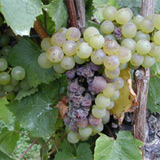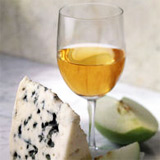Botrytis cinerea is a fungus that affects many plant species, although its most notable hosts may be wine grapes. In viticulture, it is commonly known as 'botrytis bunch rot'; in horticulture, it is usually called 'grey mould'. The fungus gives rise to two different kinds of infections on grapes. The first, grey rot is the result of consistently wet or humid conditions, and typically results in the loss of the affected bunches.
The second, noble rot, occurs when drier conditions follow wetter, and can result in distinctive sweet dessert wines, such as Sauternes or Aszu of Tokaj. The species name Botrytis cinerea is derived from the Latin for 'grapes like ashes'; although poetic, the 'grapes' refers to the bunching of the fungal spores, and "ashes" just refers to the greyish colour of the spores en masse.
In the Botrytis infection known as 'noble rot' (pourriture noble in French), the fungus removes water from the grapes, leaving behind a higher percent of solids, such as sugars, fruit acids and minerals. This results in a more intense, concentrated final product.
Botrytis complicates wine making by making fermentation more complex. Botrytis produces an anti-fungal that kills yeast and often results in fermentation stopping before the wine has accumulated sufficient levels of alcohol. Makers of fine German dessert wines have been known to take fermenting tubs of wine into their homes to nurture the yeast through the night to assure that the alcohol level reaches legal minimums for the product to be called wine.
Grapes typically become infected with Botrytis when they are ripe, but when then exposed to drier conditions become partially raisined and the form of infection brought about by the partial drying process is known as noble rot. Grapes when picked at a certain point during infestation can produce particularly fine and concentrated sweet wine. Some of the finest Botrytis wines are literally picked berry by berry in successive 'tris' (French for 'selections').











